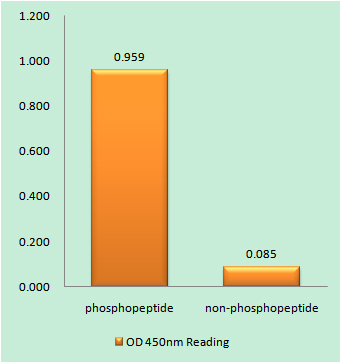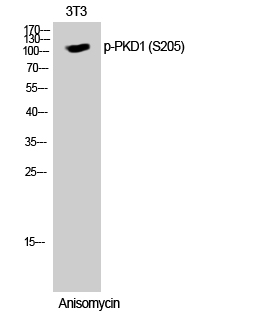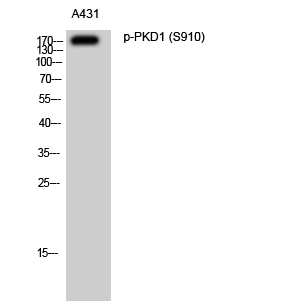
Catalog: YP0332
Size
Price
Status
Qty.
200μL
$600.00
In stock
0
100μL
$340.00
In stock
0
50μL
$190.00
In stock
0
Add to cart


Collected


Collect
Main Information
Target
PKD1
Host Species
Rabbit
Reactivity
Human, Mouse, Rat
Applications
WB, IHC, IF, ELISA
MW
117kD (Observed)
Conjugate/Modification
Phospho
Detailed Information
Recommended Dilution Ratio
WB 1:500-1:2000; ELISA 1:10000; IF 1:50-200
Formulation
Liquid in PBS containing 50% glycerol, 0.5% BSA and 0.02% sodium azide.
Specificity
Phospho-PKD1 (S910) Polyclonal Antibody detects endogenous levels of PKD1 protein only when phosphorylated at S910.The name of modified sites may be influenced by many factors, such as species (the modified site was not originally found in human samples) and the change of protein sequence (the previous protein sequence is incomplete, and the protein sequence may be prolonged with the development of protein sequencing technology). When naming, we will use the "numbers" in historical reference to keep the sites consistent with the reports. The antibody binds to the following modification sequence (lowercase letters are modification sites):RVsIL
Purification
The antibody was affinity-purified from rabbit antiserum by affinity-chromatography using epitope-specific immunogen.
Storage
-15°C to -25°C/1 year(Do not lower than -25°C)
Concentration
1 mg/ml
MW(Observed)
117kD
Modification
Phospho
Clonality
Polyclonal
Isotype
IgG
Related Products
Antigen&Target Information
Immunogen:
The antiserum was produced against synthesized peptide derived from human PKD1/PKC mu around the phosphorylation site of Ser910. AA range:863-912
show all
Specificity:
Phospho-PKD1 (S910) Polyclonal Antibody detects endogenous levels of PKD1 protein only when phosphorylated at S910.The name of modified sites may be influenced by many factors, such as species (the modified site was not originally found in human samples) and the change of protein sequence (the previous protein sequence is incomplete, and the protein sequence may be prolonged with the development of protein sequencing technology). When naming, we will use the "numbers" in historical reference to keep the sites consistent with the reports. The antibody binds to the following modification sequence (lowercase letters are modification sites):RVsIL
show all
Gene Name:
PRKD1
show all
Protein Name:
Serine/threonine-protein kinase D1
show all
Other Name:
PRKD1 ;
PKD ;
PKD1 ;
PRKCM ;
Serine/threonine-protein kinase D1 ;
Protein kinase C mu type ;
Protein kinase D ;
nPKC-D1 ;
nPKC-mu
PKD ;
PKD1 ;
PRKCM ;
Serine/threonine-protein kinase D1 ;
Protein kinase C mu type ;
Protein kinase D ;
nPKC-D1 ;
nPKC-mu
show all
Database Link:
Background:
PRKD1 is a serine/threonine kinase that regulates a variety of cellular functions, including membrane receptor signaling, transport at the Golgi, protection from oxidative stress at the mitochondria, gene transcription, and regulation of cell shape, motility, and adhesion (summary by Eiseler et al., 2009 [PubMed 19329994]).[supplied by OMIM, Nov 2010],
show all
Function:
Catalytic activity:ATP + a protein = ADP + a phosphoprotein.,enzyme regulation:Activated by diacylglycerol and phorbol esters.,Function:Calcium-independent, phospholipid-dependent, serine- and threonine-specific kinase involved in resistance to oxidative stress.,PTM:Phosphorylation of Ser-738 and/or Ser-742 in activated PKD is mediated by transphosphorylation (By similarity). Phosphorylation of Tyr-463 mediated by the Src/Abl pathway in response to oxidative stress activates the kinase.,similarity:Belongs to the protein kinase superfamily.,similarity:Belongs to the protein kinase superfamily. CAMK Ser/Thr protein kinase family. PKD subfamily.,similarity:Contains 1 PH domain.,similarity:Contains 1 protein kinase domain.,similarity:Contains 2 phorbol-ester/DAG-type zinc fingers.,subunit:Interacts (via N-terminus) with ADAP1/CENTA1. Interacts with Src.,
show all
Cellular Localization:
Cytoplasm . Cell membrane . Golgi apparatus, trans-Golgi network . Translocation to the cell membrane is required for kinase activation.
show all
Tissue Expression:
Placenta,Testis,
show all
Research Areas:
>>Rap1 signaling pathway ;
>>Aldosterone synthesis and secretion ;
>>Chemical carcinogenesis - reactive oxygen species
>>Aldosterone synthesis and secretion ;
>>Chemical carcinogenesis - reactive oxygen species
show all
Signaling Pathway
Reference Citation({{totalcount}})
Catalog: YP0332
Size
Price
Status
Qty.
200μL
$600.00
In stock
0
100μL
$340.00
In stock
0
50μL
$190.00
In stock
0
Add to cart


Collected


Collect
Recently Viewed Products
Clear allPRODUCTS
CUSTOMIZED
ABOUT US
Toggle night Mode
{{pinfoXq.title || ''}}
Catalog: {{pinfoXq.catalog || ''}}
Filter:
All
{{item.name}}
{{pinfo.title}}
-{{pinfo.catalog}}
Main Information
Target
{{pinfo.target}}
Reactivity
{{pinfo.react}}
Applications
{{pinfo.applicat}}
Conjugate/Modification
{{pinfo.coupling}}/{{pinfo.modific}}
MW (kDa)
{{pinfo.mwcalc}}
Host Species
{{pinfo.hostspec}}
Isotype
{{pinfo.isotype}}
Product {{index}}/{{pcount}}
Prev
Next
{{pvTitle}}
Scroll wheel zooms the picture
{{pvDescr}}


















